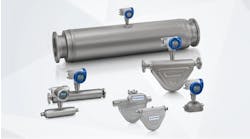This Month’s Puzzler
I’m fresh out of college and have been handed a project for which I need help. I’m installing a centrifuge for concentrating a pharmaceutical product from a reactor’s mother liquor. This is an expansion plant, designed by corporate engineering, for handling a new process.
The mother liquor is fairly sticky. I only have two data points: 31 cP at 108°F and 72 cP at 72°F. With the product, in a concentration of 13% by mass, the viscosity is 52 cP, and 101 cP, respectively. I am told the product starts to degrade above 115°F.
The density ratio between the product and the liquor is 1.3:1 for the batch stack centrifuge. I read that upstream factors could affect this ratio.
I still haven’t figured out how I’m going to do the cleaning-in-place, given the sensitivity of the product to low pH and high pH. I’m worried about residual materials.
My problem primarily is instrumentation because we are under orders to reduce the labor costs per batch. I’m kind of on my own here. I have some ideas on what controls are critical versus just nice to have. What do you suggest as far as instrumentation?
Assess Multiple Issues
Consider the following points:
1. There are various types of centrifuges based on speed, processing capacity and other specific requirements such as temperature control, particle size control, etc. For selecting a centrifuge suitable for your application, seek help from your company experience and experience of vendors. Of course, you need to have relevant data such as viscosity and density profiles, cleaning requirements, and processing rates.
2. In terms of instrumentation, aspects to keep in mind include:
• speed measurement (tachometers) and control;
• vibration alarms and interlocks;
• instruments with appropriate vibration pads or isolators because some vibration is to be expected at/near the centrifuge;
• temperature control and high temperature alarms because of concerns about high temperature degradation;
• appropriate mitigation systems, alarms, and interlocks if high temperature degradation is likely to cause a runaway exotherm;
• gas monitors at strategic locations (e.g., seals, flanges, gears) if flammable species are involved;
• cable routing that provides protection to the cable, actuator and associated equipment in the event of a fire;
• low temperature alarms if low temperature is anticipated to increase viscosity substantially; and
• interlocks to prevent opening the centrifuge while it is in motion.
3. Provide a strong foundation for the expected centrifugal forces.
4. Ensure effective access for maintenance ingress/egress.
GC Shah, Consultant
Houston
Treat Centrifuge With Respect
Ah, the old sink-or-swim treatment. Such situations happen many times during a career. In retrospect, I would say it builds character but it didn’t seem that way when I went through it the first time at a remote Anheuser-Busch plant where I faced two plant expansions simultaneously.
A lack of physical properties is a common problem. A lot can happen to fluids with a change in temperature.
I suggest ordering Zahn cups to measure samples of all the fluids you can get: feed, heavy and light. Zahn cups should be part of every engineer’s tool kit; they measure viscosity based on the capillary flow of liquid through a known hole diameter. Take measurements to fill in and expand the temperature range.
You can estimate density using a graduated cylinder and a weigh scale.
Most manufacturers can provide automatic control of their centrifuges. As a basic shopping list, consider my recommendations shown in the provided figure (Figure 1).
Figure 1. Reader suggests considering these “must have” (red) and “nice-to-have” (blue) controls for disk-stack centrifuge.
There are two categories of measurement: those for reliability and those for performance. For reliability, you should watch oil pressure, vibration, speed, bearing performance and, certainly, the oil temperature. For performance, measure the mass flow rates of the feed and the mother liquor. You can determine the flow rates of the concentrate, i.e., the heavy stream, if enough liquid is left in it.
Otherwise, the flow meter may foul too much to be useful. It is better to measure the two liquid streams and do a material balance for the heavies. One approach might be to put the heavies in a tank with a weigh cell and have the software do the material balance. This all can be automated in your control system.
One of the greatest risks to a centrifuge is ramping up and ramping down. In particular, the machine is most at risk during a sudden power failure. It’s a good idea to put the centrifuge controls on a separate controller with a dedicated uninterruptible power supply (UPS) as noted on the figure.
You also should set up supervisor-level security on the programming to prevent tampering. Because a whirling piece of steel could leave a Tasmanian-devil-size disaster if an accident occurred, I recommend putting the centrifuge under the strictest control: rigorous management of change (MOC) procedure; lock out/tag out (LOTO); and annual inspections of mechanical, foundation and electrical.
As for machine performance, I suggest Coriolis mass flow meters because they can provide density, mass flow rate, and volumetric flow rate and are built for pharmaceutical service. Just be careful how you install the meters! Put them in vertical lines that can drain; keep the transmitters remote so they aren’t affected by temperature when you clean-in-place (CIP) the tube.
Although not commonly done, you may want to automatically calculate the material balance using a process controller. Don’t count on cost savings from reducing labor with controls; the downtime alone will kill your budget while your expensive instrument techs figure out what’s wrong.
As for CIP, make sure you keep the first flush below the temperature of concern for product quality; burnt material tends to find its way into the product. This concern also is important regarding pH.
Your mention of “upstream factors” has me concerned. You may need to adjust feed stream density on-the-fly. If you haven’t already, install a feed tank upstream of the centrifuge where you can sample the density or even measure it directly and then, if needed, adjust the density of the feed with water. Take care that the feed tank is well-mixed for good sampling.
Dirk Willard, consultant
Wooster, Ohio
February’s Puzzler
We are re-tasking a batch fluid-bed dryer we had used for a different pharmaceutical product that has become a generic. I have several concerns: 1) the old particle size was larger than that of the new one which has a slightly higher density; 2) the new powder could be a fire risk — we don’t have safety data but still are pushing ahead with the project; 3) we only have incomplete maintenance data on the blower; 4) the screen and baghouse are severely corroded; 5) the electric heater leaks tramp air; and 6) the exhaust fan has been upsized twice and also is corroded.
If this dryer were a fish, I’d throw it back. Instead, I am tasked with getting this dryer up and running in three months. Because of the pandemic bottleneck, I’m not sure there’s anything I can do to make it run better.
In the future, I want to get a handle on these problems. The corrosion has me concerned. Another problem I notice is vibration in the corroded ductwork and poorly supported conduit — it jerks about an inch every time the blower starts and stops. I want to check out the fluidization against a Clark chart because I have heard of clumping complaints about the previous product.
What can I do to ensure this product campaign goes well? What do you think causes the corrosion? Why do you think the exhaust fan size was increased? Should I be concerned about preparing this dryer for use before the safety data are in?
Send us your comments, suggestions or solutions for this question by January 7, 2022. We’ll include as many of them as possible in the February 2022 issue and all on ChemicalProcessing.com. Send visuals — a sketch is fine. E-mail us at [email protected] or mail to Process Puzzler, Chemical Processing, 1501 E. Woodfield Rd., Suite 400N, Schaumburg, IL 60173. Fax: (630) 467-1120. Please include your name, title, location and company affiliation in the response.
And, of course, if you have a process problem you’d like to pose to our readers, send it along and we’ll be pleased to consider it for publication.



